Project #1: IoT-enabled smart mobility devices for aging and rehabilitation
Faculty Mentors: Ladislau Bölöni and Damla Turgut
Research: Mobility devices such as four legged walkers, wheeled walkers (rollators) and canes are used by millions of people worldwide both as a way for the elderly to retain mobility as well as a rehabilitation tool for re-acquiring mobility after trauma. On the other hand, the use of walkers is also associated with many injuries, falls and broken limbs. Augmenting these devices with IoT devices allows us to provide many benefits. They can be used to provide better information to the physiotherapist about the progress of rehabilitation. Equipped with encoders and inertial sensors, rollators in combination with tagged users can be used for gait analysis and health monitoring. Lightweight IoT augmentation of off-the-shelf walkers in a home environment can be used to monitor prescription compliance and for automatically detecting dangerous use patterns that can lead to injuries (See Figure 1).
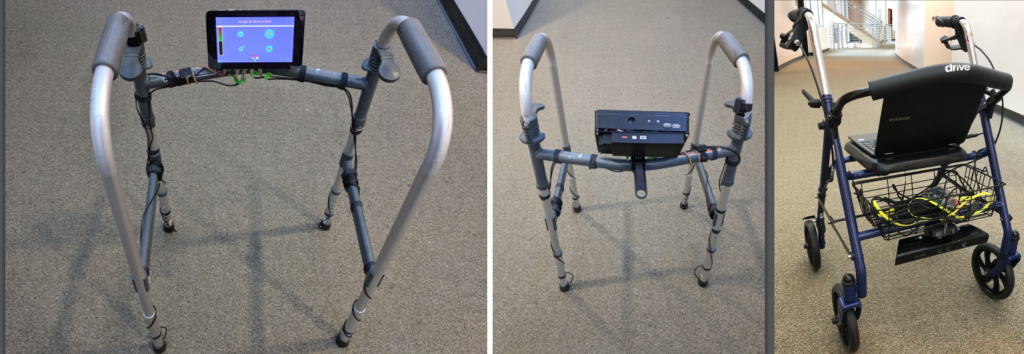
Figure 1. Examples of IoT augmented mobility aids available at the NetMoc lab. Left two pictures: a device developed in collaboration with the UCF College of Medicine. Rightmost picture: a device built by students in the 2018 REU cohort.
In this project the students will investigate ways to improve traditional mobility aids such as four legged walkers, rollators and canes by augmenting them with IoT devices and applying AI, machine learning and data analysis techniques to maximize the overall system performance and usability. The research problems the students need to address are as follows. The students will start by reading studies about the benefits and drawbacks of these devices and identify aspects of the traditional mobility aids that can benefit from IoT augmentation. They will also investigate what type of IoT devices are suitable for such a deployment, considering size, reliability, cost, energy consumption and other relevant factors. The students will propose a design specifying the sensors and actuators to deploy, how to position them on the mobility device and how to connect them with each other and the internet. The proposed design will be discussed and agreed upon with the faculty advisors. The students will implement the new IoT augmented mobility device either by modifying one of the several prototypes already available in the NetMoc lab, or by building a new device from scratch, but relying, as much as possible, on off-the-shelf devices. The second part of the design project involves maximizing the benefits of the proposed approach through data processing and actuation decisions. The students will need to research whether their proposed architecture is more suitable for a local “edge” or “fog” computing model, or through remote processing (the “cloud computing” model). The students will also need to decide what AI/ML techniques can be used to process the data and, if needed, generate actuation commands. Examples of these techniques might include but are not limited to: deploying a deep learning-based classifier to detect incorrect or dangerous use patterns, mine collected data for patterns that might indicate a change in the patient’s condition (such as minor strokes), or provide haptic, audio or visual feedback to the patient for teaching the correct use of the mobility device. The students will validate the proposed system using experiments using healthy volunteers.
Research Project 2: IoT and augmented reality: agents with pervasive awareness, appearance, and abilities
Faculty Mentors: Gerd Bruder and Greg Welch
Research: Students on this project will work with the researchers on combining aspects of a pediatric physical-virtual patient bed (PVPB) and aware mixed reality humans to achieve a novel physical-virtual pediatric patient simulator with awareness of her surroundings and the ability to communicate with her parents and caregivers. Human subject research will be used to explore the impact of such awareness on caregiver trainees, e.g., the effect of a child crying in response to being told the parent is not near (at home) or crying while a caregiver attempts to give an injection and the child recognizes it and becomes upset. Awareness of surrounding humans and their actions are particularly important for pediatric patients who have experience of abuse at the hands of adults, and a lack of awareness is particularly important for pediatric patients with a systemic deadly infection (sepsis). We will replicate both circumstances in human-subject experiments. See Figure 2 for example scenarios.
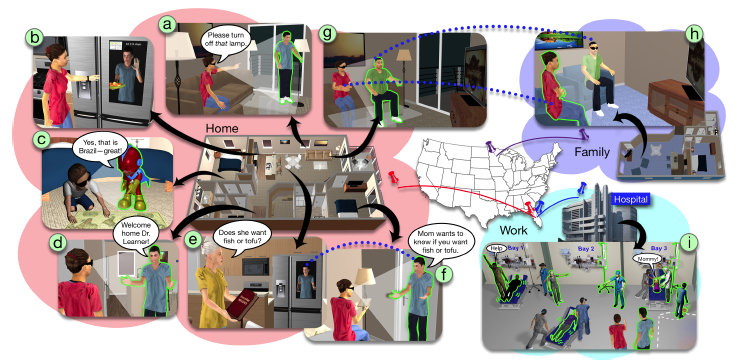
Figure 2. Futuristic example use-cases for a Dr. Learner, M.D., with her Augmented Reality Agent (ARA) at home (left) and work (lower right), and in telepresence mode (upper right). A figure outlined in bright green indicates a 3D embodiment in the room, seen with the aid of AR “glasses”.
This project allows students to perform research on both the hardware side of IoT as well as on research on human-subject experiments enabled by the IoT devices. For the hardware aspects, the students will perform research on embedded controllers and sensor/actuator systems to support AR awareness and abilities (output/actuation). For the human-subject experiment, the students will design and run an experimental study on a specific aspect of AR agent awareness, appearance, and abilities. This will include the investigation of the effects of the characteristics of a visual manifestation of an agent on the interacting humans. One such example is the effect of age, gender, and race on the interacting human, for example in a setting where the human is a patient in a hospital and the agent is a healthcare aide that controls IoT devices in a smart environment. IRB approval (if needed) being sought as much in advance as possible so there is a chance to run subjects and get results while still on site.
Research Project 3: Designing mobility services using large-scale data from a smart city testbed
Faculty Mentors: Samiul Hasan and Damla Turgut
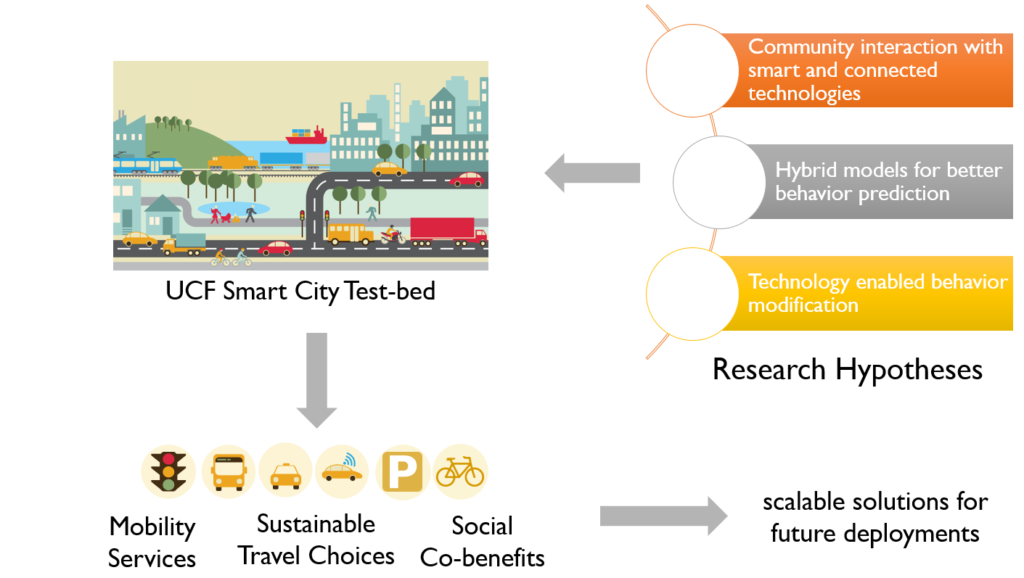
Figure 3: UCF Smart City Framework
Research: A smart city relies on technology deployment and synthesis of digital infrastructure with a better provision of urban services, knowledge communication, and social infrastructure. For instance, in its recent report, Beyond Traffic 2045, the US Department of Transportation emphasizes that new sources of travel data can potentially improve travel experience and enhance transportation systems management and investment decision processes. Thus, many cities in the U.S have taken initiatives to build smart city testbeds with a strong focus in transportation. The proposed project will leverage a smart city testbed being deployed at the UCF campus (Figure 1), built by a partnership between the Florida Department of Transportation (FDOT), UCF and MetroPlan Orlando.
As part of the ongoing smart city research at UCF, under the proposed REU project, students will perform several activities: they will access the data infrastructure and FDOT servers that seamlessly collect data from the sensors of the smart city testbed; collect and analyze mobility traces and real-time information provided by the testbed sensors and UCF mobile phone app infrastructure; build a data-driven mobility model for UCF community members (including students and employees); design a mobility service that provides the real-time estimates of a transportation variable (e.g., parking availability) to campus residents; contribute to a smart city analytics platform by integrating the developed service with the platform; and assess the benefits of a smart city application to local transportation system. See Figure 3.
Research Project 4: IoT-enabled peer-to-peer energy trading
Faculty Mentors: Qun Zhou and Damla Turgut
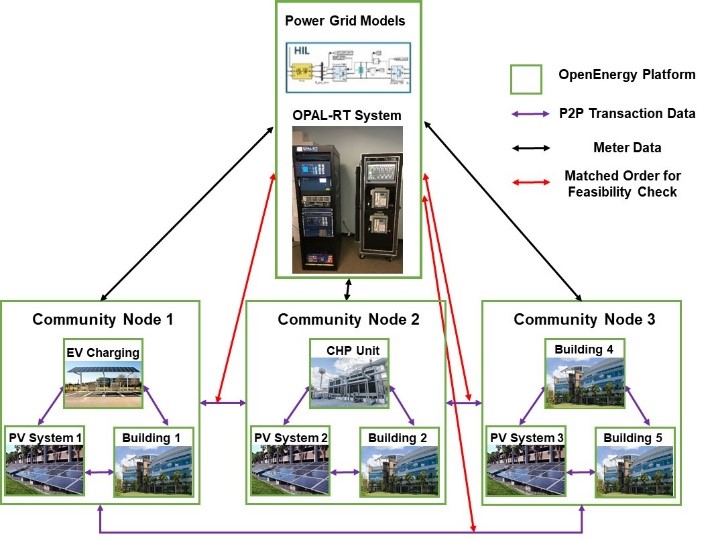
Figure 4. EnergyTrading. Using the UCF campus as a testbed for research on IoT enabled P2P energy trading.
Research: The emerging smart grid and residentially deployed solar energy panels transform the traditional, centralized energy market into one where the individual users can be simultaneously producers and consumers of energy. As the production ability and needs vary in time, the needs of the customers and the producers of surplus energy can be reconciled through a distributed peer-to-peer energy trading model. This requires research into IoT devices that can accurately sense, track and predict energy consumption and production. The students will start by studying the structure of the current energy market and peer-to-peer economy models. By integrating these two concepts the students will research novel P2P trading architectures consisting of financial, physical and cyber layers. To evaluate their proposed models, the students will use the buildings on the UCF campus as a testbed (See Figure 4). The campus power grid is modeled through a hardware-in-the-loop testing. Students will collect data from IoT devices in different buildings, analyze the IoT data and conduct predictive analytics for building energy consumption patterns. Using this data, the students will design optimal trading strategies which exchange information through the IoT communication layer.
Research Project 5: Manufacturing IoT sensors: a flexible and wearable UV radiation sensor based on metal oxide semiconductors
Faculty Mentors: Hyoung Jin Cho and Ladislau Bölöni
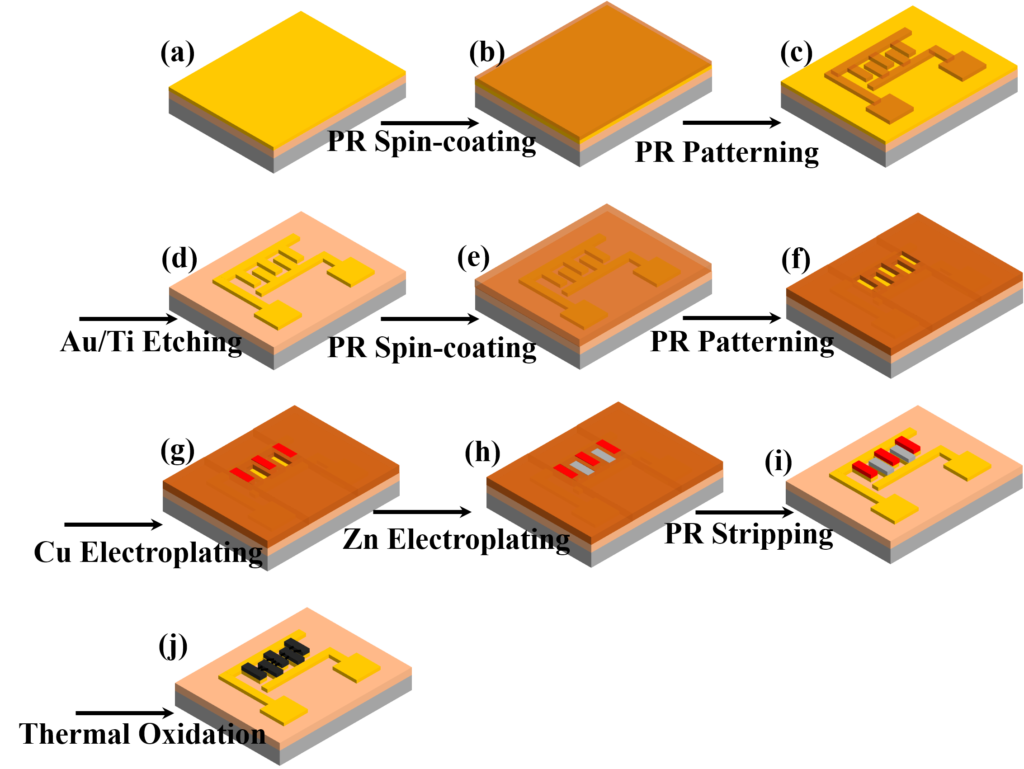
Figure 5. Fabrication steps for a UV radiation sensor based on MOS heterojunctions.
Research: Metal oxide semiconductors (MOSs) have been widely studied for various applications in environmental monitoring. These materials could be structured in the forms of particles, wires and sheets and used for gas sensors and light sensors for example. Due to a large span of band gap energy available from MOSs, a specific wavelength can be detected by the adequate selection of a material. The radiation in the UV or near UV spectrum region could effectively reduce microbial activities but also known to be a cause for skin cancer and a epidemiologic risk factor when the amount of exposure becomes excessive. In this project, an REU student will design and produce a flexible and wearable MOS based sensors for UV/near UV radiation detection. For this, this REU project module will utilize (a) a MOS material library to design and fabricate a sensor that responds to UV/n-UV wavelength (b) a confined nanoscale structures such as nanowires to enhance the sensitivity that arises from efficient transport of charge carriers and optical excitations (c) a facile fabrication technique such as electroplating and in-situ thermal oxidation to create a sensor on a flexible substrate (d) algorithm that can predict human health risk based on the correlation found from the sensor measurements. The student will be required to study heterojunction structures using different MOSs to enhance the sensitivity. Among these heterostructured configurations, p-n junction properties will be investigated which then can be used for enhanced UV/near-UV radiation detection. In this work, a design and fabrication route for in-situ synthesis of p-type and n-type MOS nanoscale features and their heterojunction properties with a well-defined device configuration will be studied for flexible, wearable UV sensors based on our prior work. The student will learn and implement a machine learning strategy to endow smartness to sensors and sensor network utilizing the wireless data transfer and computation based on the measured data from the developed wearable sensors for the determination of health risk factor. Figure 5 shows the fabrication steps by which p-type CuO and n-type ZnO heterojunctions are made and used for a UV radiation sensor.
Research Project 6: Processing data from a visual IoT sensor of fluid/structure interactions with machine learning
Faculty Mentor: Andrew Dickerson and Damla Turgut

Figure 6. Fluid jet emmited from elastic orifice.
Research: We envision an IoT that not only provides us data via countless sensors, many vision-based, but uses this immense amount of data to predict physical events before they happen. This is particularly appealing in cases where the underlying physics are not well-understood. Thus, it is imperative we investigate the integration machine learning and IoT for phenomena that currently have no established theoretical models. REU students will begin by filming free fluid jets ejected through soft orifices, similar to that shown in Figure 6. Free jet stability is greatly influenced by the deformability of the solid interface through which the fluid exits, but this highly-coupled interaction has not been formally characterized. Multiple experiments will be run to draw a relationship between jet stability and solid material properties and generate data. Students will extract physical dimensions from video, such as perturbation wave number and breakup distance, with open source MATLAB and Tracker tools. The data collection phase should consume roughly two weeks. By surveying literature on well-established machine learning techniques, students will choose and justify the best tool for integration of basic experimental data. Their chosen tool will be refined and trained with existing stability data and tested against data withheld from training, with the goal of predicting jet characteristics from untested materials. Students will be encouraged to begin with existing open source code and modify for application to fluid flow.
Project #7: IoT augmented physical scale model of a suburban home
Faculty Mentors: Damla Turgut and Ladislau Bölöni
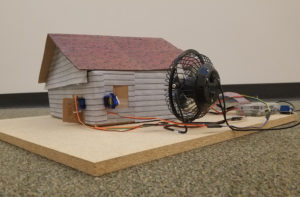
Figure 7. An early prototype of ScaledHome. A Raspberry Pi 3 controller collects data from sensors embedded in 4 internal rooms and controls actuators opening/closing doors. A remotely controlled fan and heat lamp provides a simplified climate control.
Research: We envision an IoT augmented physical scale model of a suburban home. The REU students will develop building blocks for a model home, which allows quick configuration changes, such as changing the number of levels and rooms. The students will also design and assemble Raspberry Pi 3-based sensor packs that can be deployed in every room and actuators that implement the opening and closing of doors and windows. This architecture will allow the students to perform accelerated experiments in hypothetical external circumstances, and in a variety of environments that would be prohibitively expensive to do with real world homes. The students will use AI techniques to implement a smart-home behavior that reads the sensors and automatically reacts to environmental events. The students will use data science to process the data collected through the environment.
Project #8: Privacy aware health monitoring for the elderly
Faculty Mentors: Ladislau Bölöni and Damla Turgut
Research: Health monitoring in sensor enabled environments can significantly contribute to the health and safety of the elderly. However, such monitoring systems also present significant privacy issues. This project will investigate the efficiently of health monitoring by a heterogeneous group of IoT sensors deployed in a home, in order to determine the minimum amount of sensor readings, that is, the most private setting in which specific health events, such as falls or asthma attacks can be reliably detected. The project will involve data collection using a collection of sensors and IoT devices, and the use of IoT algorithms to classify and predict the events.

